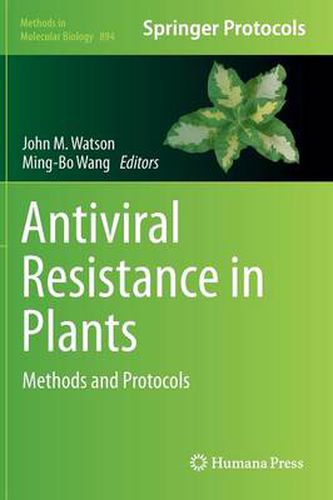Readings Newsletter
Become a Readings Member to make your shopping experience even easier.
Sign in or sign up for free!
You’re not far away from qualifying for FREE standard shipping within Australia
You’ve qualified for FREE standard shipping within Australia
The cart is loading…






This title is printed to order. This book may have been self-published. If so, we cannot guarantee the quality of the content. In the main most books will have gone through the editing process however some may not. We therefore suggest that you be aware of this before ordering this book. If in doubt check either the author or publisher’s details as we are unable to accept any returns unless they are faulty. Please contact us if you have any questions.
Studies related to pathogen-mediated virus resistance in plants were instrumental in providing some of the historical observations which ultimately led to the vital discovery of double-stranded RNA (dsRNA)-induced gene silencing or RNA interference (RNAi), which has since revolutionized research on plant-virus interactions. In Antiviral Resistance in Plants: Methods and Protocols, expert researchers in the field detail many of the methods which are now commonly used to study the phenomenon of RNA silencing in relation to viral infections of plants. These include methods and techniques for the isolation and quantitative/qualitative analyses of plant small 21-24 nucleotide RNAs such as small interfering RNAs (siRNAs) and microRNAs (miRNAs) as well as the analysis and manipulation of virus-induced gene silencing (VIGS) in both monocotyledonous and dicotyledenous plants and the use of hairpin RNA (hpRNA) transgenes. Written in the highly successful Methods in Molecular Biology ™ series format, chapters include introductions to their respective topics, lists of the necessary materials and reagents, step-by-step, readily reproducible laboratory protocols, and key tips on troubleshooting and avoiding known pitfalls.
Authoritative and practical, Antiviral Resistance in Plants: Methods and Protocols seeks to aid scientists in the further study of this crucially important botanical trait.
$9.00 standard shipping within Australia
FREE standard shipping within Australia for orders over $100.00
Express & International shipping calculated at checkout
This title is printed to order. This book may have been self-published. If so, we cannot guarantee the quality of the content. In the main most books will have gone through the editing process however some may not. We therefore suggest that you be aware of this before ordering this book. If in doubt check either the author or publisher’s details as we are unable to accept any returns unless they are faulty. Please contact us if you have any questions.
Studies related to pathogen-mediated virus resistance in plants were instrumental in providing some of the historical observations which ultimately led to the vital discovery of double-stranded RNA (dsRNA)-induced gene silencing or RNA interference (RNAi), which has since revolutionized research on plant-virus interactions. In Antiviral Resistance in Plants: Methods and Protocols, expert researchers in the field detail many of the methods which are now commonly used to study the phenomenon of RNA silencing in relation to viral infections of plants. These include methods and techniques for the isolation and quantitative/qualitative analyses of plant small 21-24 nucleotide RNAs such as small interfering RNAs (siRNAs) and microRNAs (miRNAs) as well as the analysis and manipulation of virus-induced gene silencing (VIGS) in both monocotyledonous and dicotyledenous plants and the use of hairpin RNA (hpRNA) transgenes. Written in the highly successful Methods in Molecular Biology ™ series format, chapters include introductions to their respective topics, lists of the necessary materials and reagents, step-by-step, readily reproducible laboratory protocols, and key tips on troubleshooting and avoiding known pitfalls.
Authoritative and practical, Antiviral Resistance in Plants: Methods and Protocols seeks to aid scientists in the further study of this crucially important botanical trait.